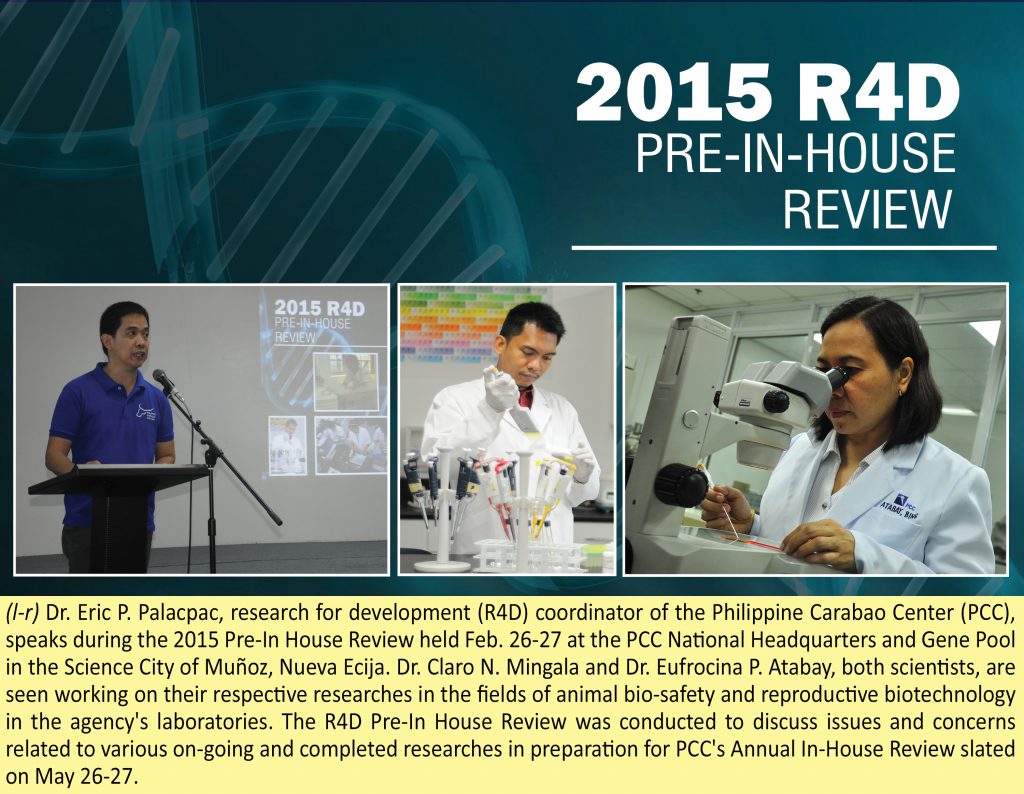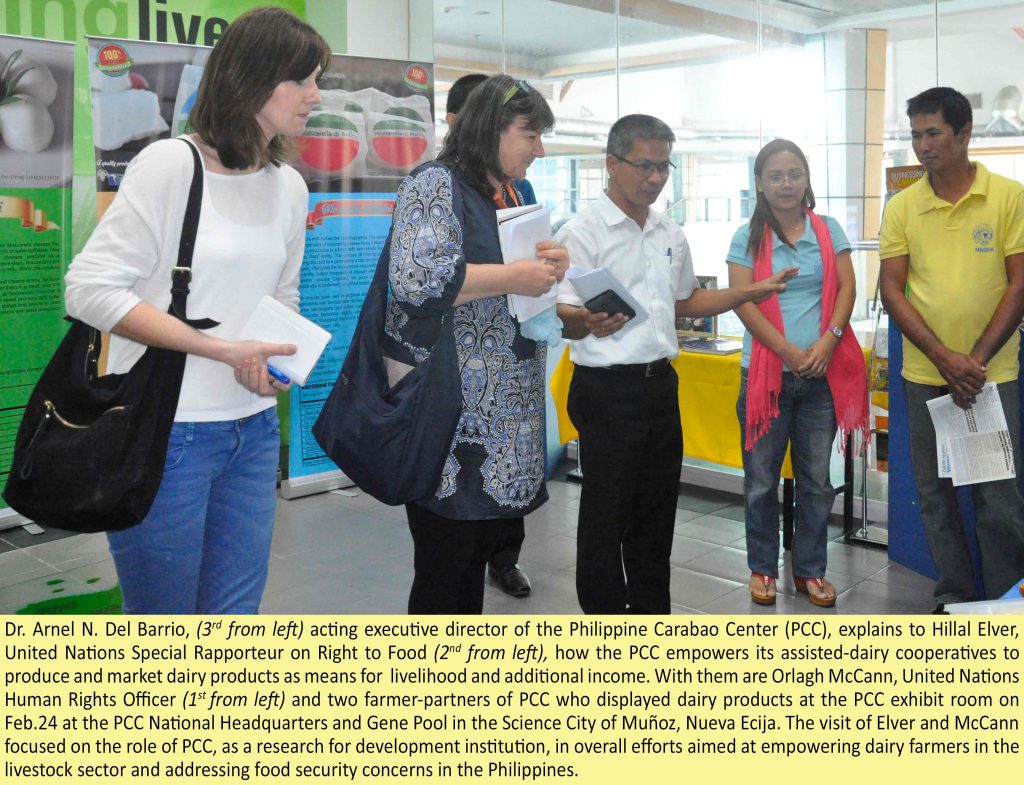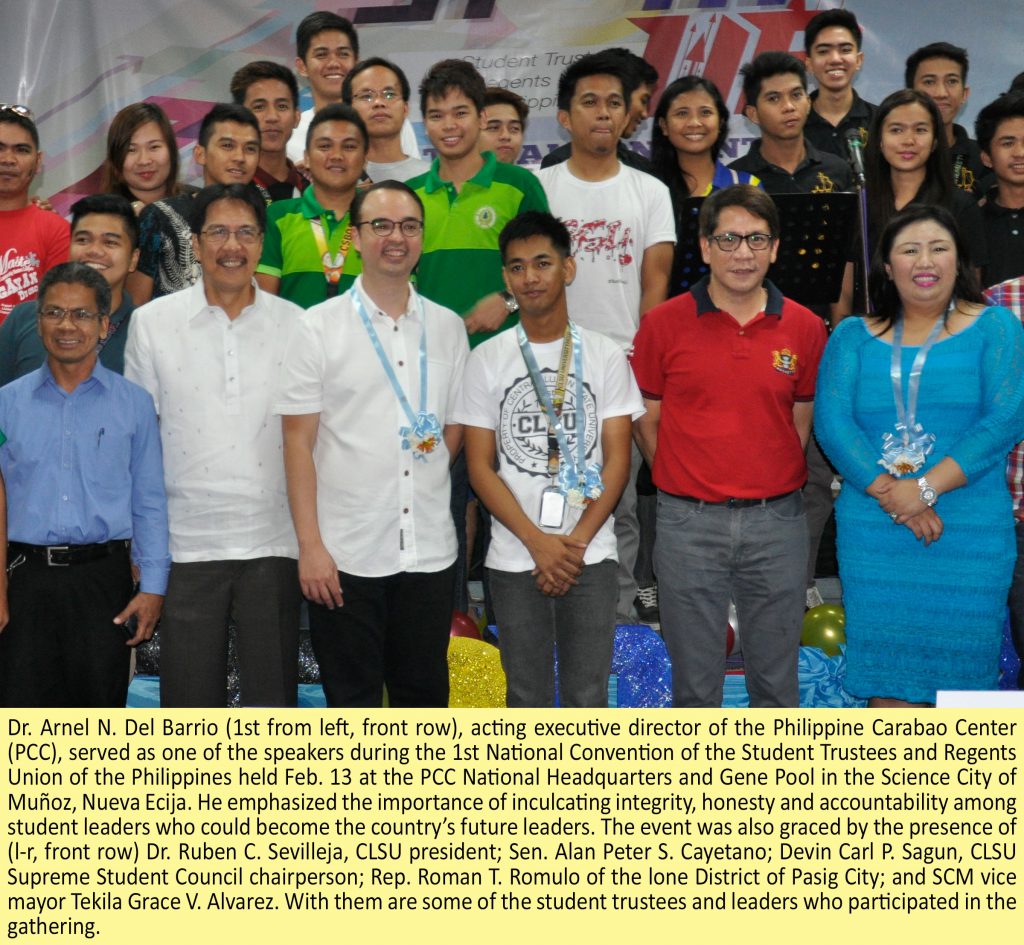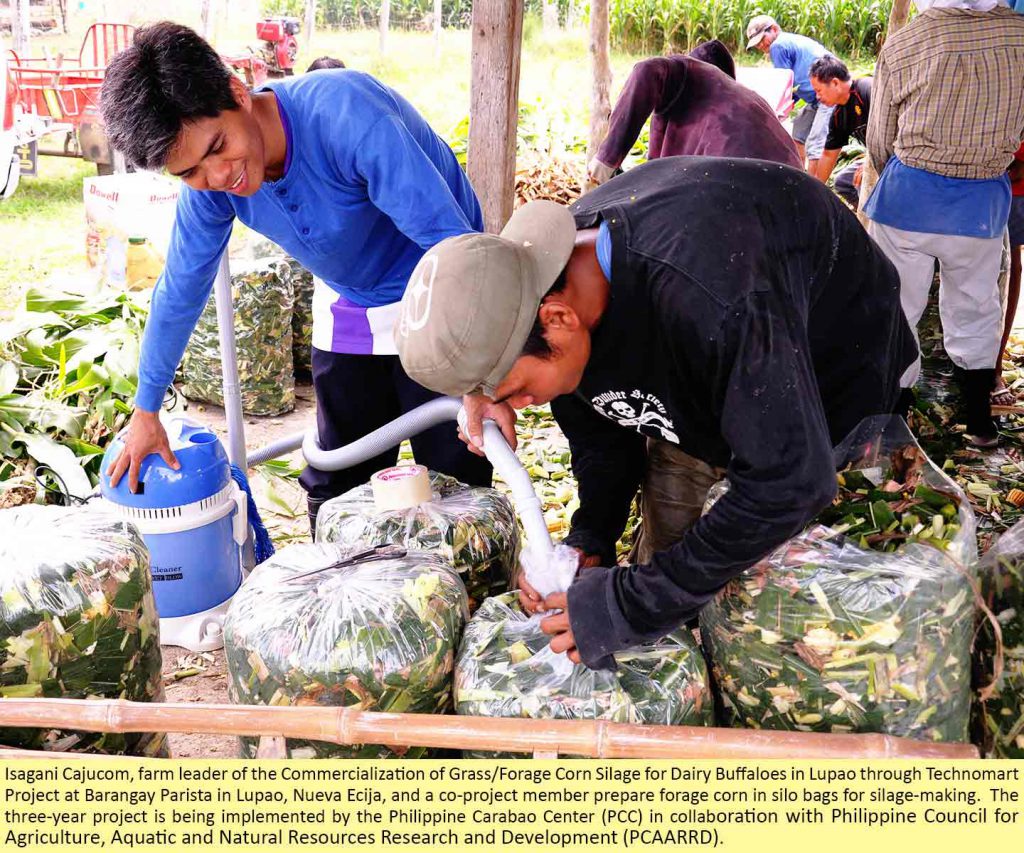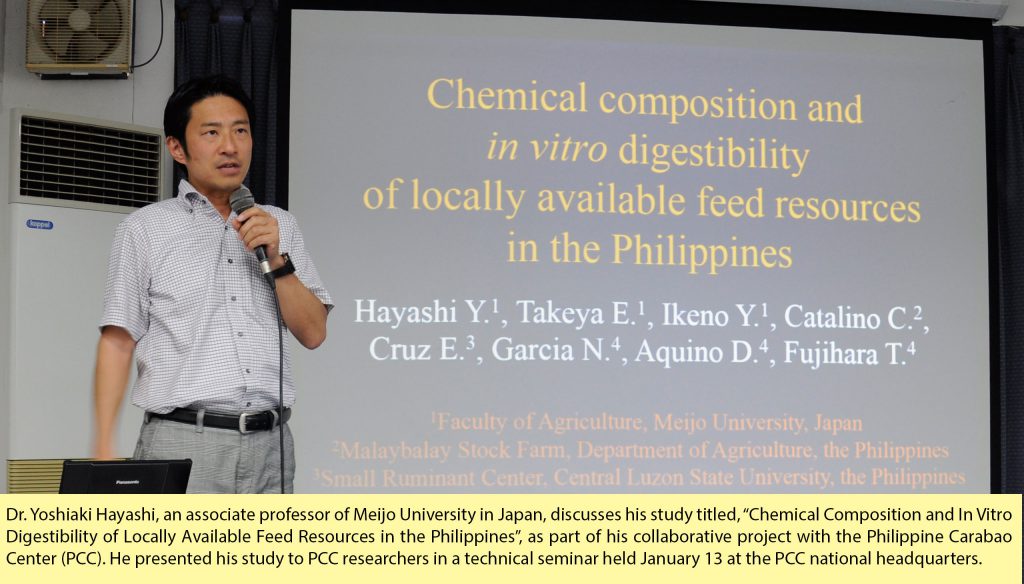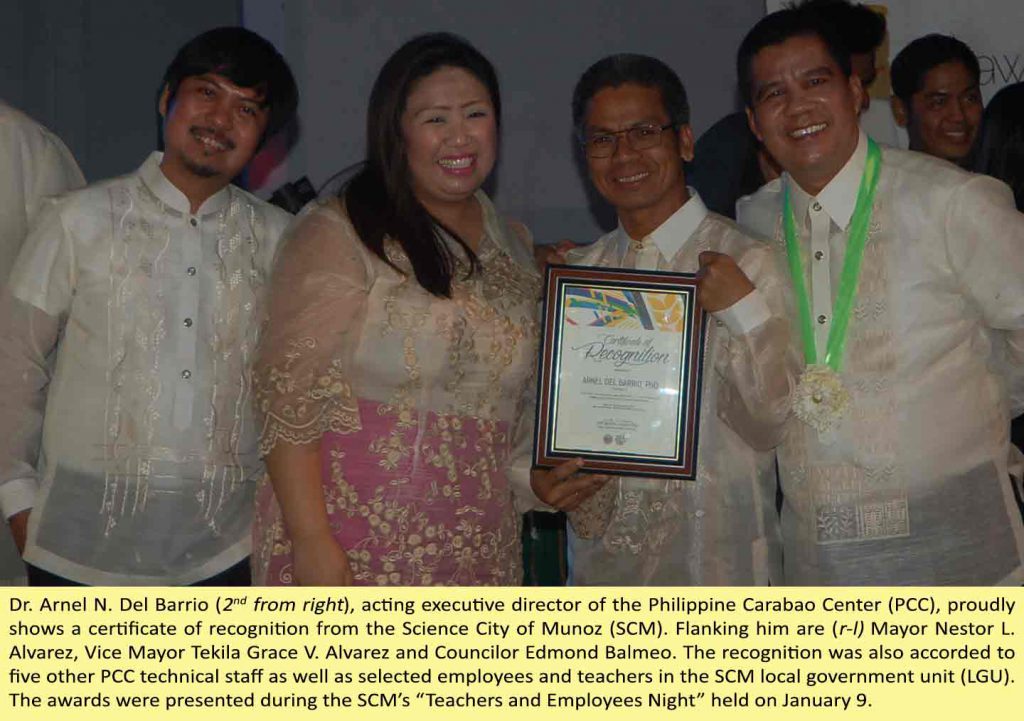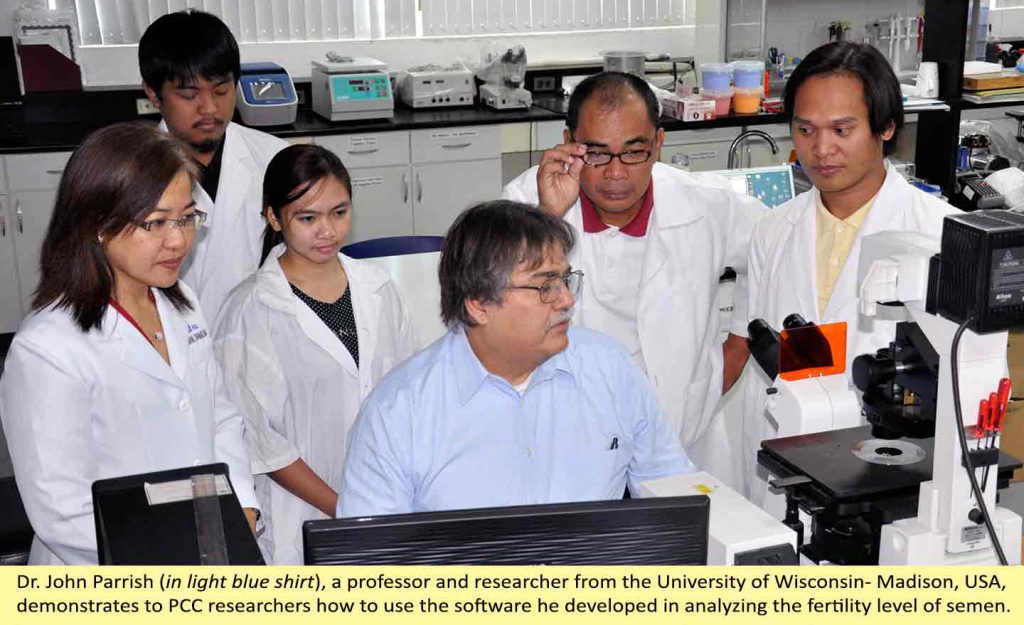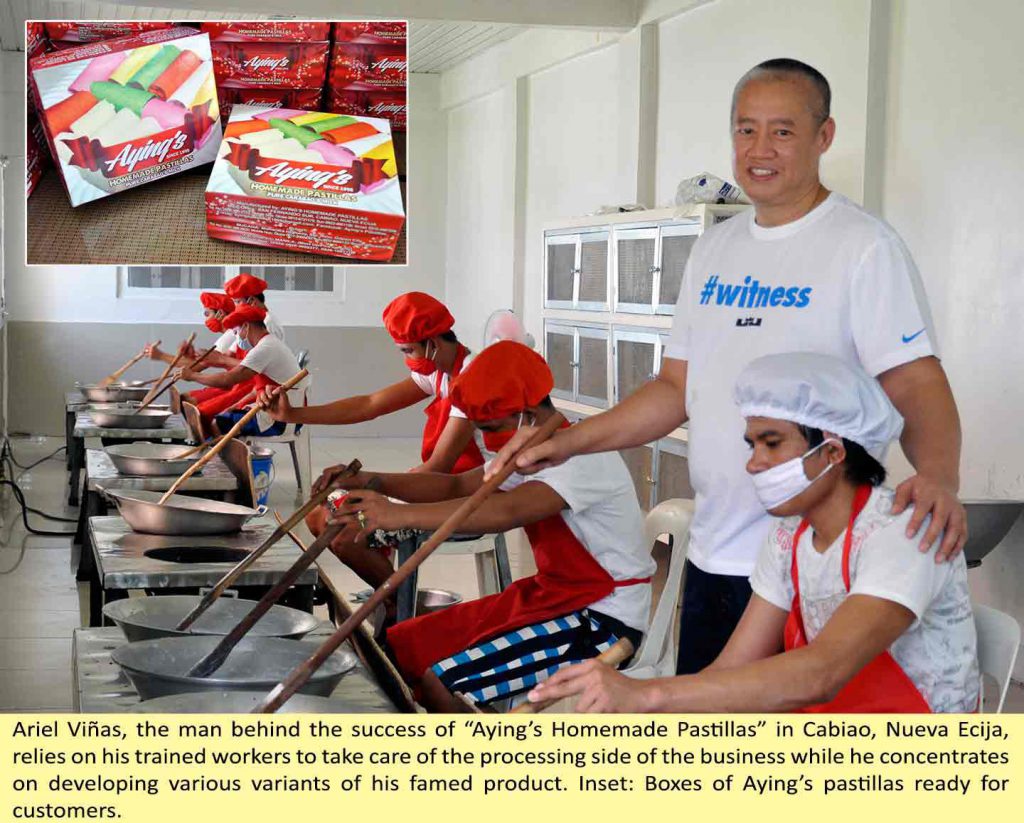Author: Chrissalyn L. Marcelo
UN special rapporteur on right to food visits PCC
PCC head attends National Convention of students
Enhanced carabao-based dairy farm enterprise thru R&D seen
Carabao-based dairy farming has become a viable enterprise in the Philippines. Experts said it is an emerging industry that is seen to have the ability to address food security and offer income-generating opportunities to Filipinos.
According to the Philippine Statistics Authority (PSA), in 2013, milk production in the country was 19.5 million liters. This was 5.59 percent higher than last year’s level of 18.5 million liters. Of this total, 33.6% were from carabao’s milk.
Despite the potential of this industry, however, local milk production can only contribute 1% of the national dairy requirement. Dairy products are the country’s third largest agricultural import after wheat and soybean meal (Philippines. Dairy and Products Annual. Oct. 2014/AgroChart.com).
To meet the demand for this commodity, milk production research and development (R&D) interventions and effective strategies to boost the supply are being continuously introduced.
Dairy R&D initiatives
As part of pursuing development goals for the dairy industry through science solutions in the country, the Philippine Council for Agriculture, Aquatic and Natural Resources Research and Development (PCAARRD has bared its Industry Strategic S&T Plan (ISP) for dairy. The Philippine Carabao Center (PCC) is seen as playing a big role in the implementation of the plan.
The PCAARRD ISP for dairy is aimed at increasing production to meet local demand and decrease import requirements by 2020.
Its strategic R&D focuses on technology transfer through the promotion of genetically improved dairy buffalo, commercialization of food safety compliant milk handling and other processing technologies and, community-based technology promotion and transfer for increased milk production.
Through S&T interventions, the PCAARRD provided funding support to seven technology transfer projects across Regions III, IV, VII and VIII through its S&T Community-Based Farm (STBCF) and TechnoMart (TM) modalities. These projects have a combined budget of Php23.9 million, wherein 70% (P16.7M) is from PCAARRD and the rest from PCC and other stakeholders.
The STBCF and TM are two important components under the Pinoy S&T Services for Farmers and Entrepreneurs (PSF) Program. These modalities are PCAARRD’s transition platform from technology demonstration to technology commercialization.
STBCF promotes wider adoption of S&T interventions to increase productivity and empower farmers in a given community. It aims for sustainable supply of raw materials in support of the TM enterprise.
The TM aims to fast-track the movement of S&T products from source to the markets, increase product value, establish and implement business matching, synchronize strategies with other sectors involved and track the road toward the commercialization of the S&T products.
Of the seven projects, four are ongoing and will be implemented until 2016. These are 1) “Commercialization of Grass/ Forage Corn Silage for Dairy Buffaloes in Lupao, Nueva Ecija through TechnoMart; 2) Community-Based S&T Project on the Preparation and Utilization of Urea-Treated Rice Straw (UTRS) as Fodder for Dairy Buffaloes; and 3) Enhancing the Carabao-Based Dairy Enterprise in Magdalena, Laguna through TechnoMart 4) Use of Flushing and Supplementation to Enhance the Carabao-Based Farms in Baybay Leyte.
The results of the on-going STBCF and TM projects will provide bases for more effective and efficient implementation of the PCAARRD ISP for Dairy.
Commercialization of Grass/ Forage Corn Silage
The project aims to: 1) establish private or coop-led commercial producers of silage in Nueva Ecija; and 2) promote community-based commercial silage production as a source of additional income for farmers.
Project leader Dr. Eric P. Palacpac, who is PCC’s R&D coordinator, said that corn silage is an enriched forage that can help address problems on nutrition and forage deficiencies during lean months. Silage-making can be easily adopted by farmers for farm use or on a commercial scale because it only requires simple equipment and low input costs, he added.
The ongoing three-year project (April 2013-March 2016) is piloted in Lupao, Nueva Ecija. A group of farmer-cooperators, whose members were selected due to their significant production of forage corn and having land availability for corn planting in the targeted area, is involved in the project.
As of September 2014, a total of 397,658 kilograms of forage/silage were produced by the selected farmer-cooperators from about 13 hectares of land. The forage/silage was sold to farmers, private farms and PCC-operated dairy farms and generated a net income of Php448,920.55.
rainings, field day, study tours and promotional activities were initiated to spur the interest of other farmers to patronize the use of silage in their animal feeding management.
Constant project monitoring and conduct of team meetings are regularly conducted to document and analyze the farmer’s feedback and report generation.
Community-based preparation, utilization of UTRS
In response to the need for sustainable production and supply of conserved forages for feeding of dairy buffaloes, the CBSTF intervention through the feeding of urea-treated rice straw (UTRS) was introduced as another dairy technology for community adoption.
“Rice straw is forage with poor quality but when treated with the right amount of urea and/or molasses, it will improve its crude protein contents from 4% to 7%,” project leader Dr. Daniel L. Aquino said.
“The improvement in the nutritive value will lead to the enhancement of its palatability and digestibility. In effect, this helps increase the feed intake and overall productivity of the buffaloes,” he added.
Three project collaborators were identified as recipients of the three-year project (April 2013- April 2016). They are the Punla Multi-Purpose Cooperative in General Natividad, Nueva Ecija, and Kapitbahayan sa Mabini Cooperative and Casile Dairy Producers Cooperative, both in Llanera, Nueva Ecija,
During the first year of its implementation, 38 dairy farmers from the three partner-cooperatives in Llanera and General Natividad towns were trained for UTRS production and feeding. They were able to produce 73 tons of UTRS from the collected 200 tons of rice straws.
Ninety-two percent of the rice straws targeted for collection for the 1st production cycle was already attained. Forty-seven percent of these were already produced as UTRS.
The UTRS were use as feeding intervention were fed to 12 lactating cows, which were on their third month of feeding intervention. The animals were able to produce 4.7 kilograms of milk per day each compared to the 3.5 kilograms milk produced from the controlled cows in the study.
For three months, each cow produced 423 kilograms of milk. This translated to a gross sale of Php17,766.00 at Php42 per liter. An additional Php3,702, or 30.20% increase in income was realized when the cows were fed with UTRS.
The actual UTRS demonstration benefited 45 farmers from Nueva Ecija and 73 farmers from Pangasinan. Based on the 2013-2016 plans, the project is aims to encourage 100 dairy farmers to adopt UTRS feeding for their dairy buffaloes and this has shown very encouraging results.
Enhancing Carabao-based Dairy Enterprise in Magdalena
The project aims to: 1) increase volume and ensure quality of raw milk collected through the establishment of community cluster milk collection system; 2) comply with food safety and GMP standards; 3) capacitate major stakeholders/partners and team members to manage and sustain a profitable carabao-based dairy enterprise through capacity-building, and 4) increase sales and profit through product development and promotion.
In order to achieve these, S&T interventions were applied. These included formation of a community/cluster milk collection system, conducting milk quality testing (raw and end-product assessment), performing laboratory analysis of dairy products produced, monitoring of record-keeping and accounting, improving product and packaging, and enhancing marketing and promotion activities.
The Magdalena Dairy Raisers Association (MADRA) was identified as the recipient of the two-year project (March 2013-March 2015).
During its first year, two milking clusters were established in Barangays Balanac and Saladsad in Magdalena town. Records showed that milk collection in these two villages increased by 66%-166% owing to the 50-80 liters collected daily compared to their previous collection of 30 liters a day. This was due to the increase of raw milk suppliers, from the previous four to 13 suppliers to an average of 18 suppliers.
The association was also provided with processing facility and was given sanitary permit. The production staff was trained for good manufacturing practice (GMP) and food safety protocol.
To improve the quality of the dairy products produced, daily milk quality testing was done both for raw and processed products.
The Department of Science and Technology (DOST) in Region-IVA conducted the microbial analysis of dairy products, such as pasteurized milk, chocomilk and white cheese, pastillas, yoghurt drink and frozen yoghurt mix.
Appropriate product packaging with label was also applied in conformance to the basic Food and Drug Authority (FDA) standards.
New packaging and labels were appropriately developed for the dairy products.
In August to December 2013, a total of 9,345 liters of milk were collected on a daily basis, an increase of 124% compared from previous year’s collection of 4,163 liters. The milk collected translated into a gross income of Php743,187 or 198% increase from the earnings of Php249,795 in the previous year.
The marketing and promotion of the dairy products were likewise improved. The product distributors now include white cheese makers, Baryo Froyo Enterprises, individual product retailers, dairy processors, Mr. Moo & More Pasalubong Center, PCAARRD and Kamay ni Hesus Shrine in Lucban, Quezon.
Use of Flushing and Supplementation in Baybay Leyte
The project aims to enhance the carabao-based dairy farms in Baybay, Leyte through wider adoption of flushing and supplementation through the STBCF modality.
The Baybay Dairy Cooperative was selected as the recipient of the three-year project (March 2013- March 2016).
As of November 2014, records showed that 110% of the milk collection targeted for three years was already achieved.
The co-op’s 29 dairy farmers were able to produce 27, 243 liters of milk owing to the increased average daily production of 4.8 liters per buffalo head compared to their previous collection of three liters a day. The lactation period was also improved from 260 days to 272 days.
Taiwanese deputy minister of agriculture visits PCC
Animal nutrition expert presents study on feed resources in PH
An associate professor from the Laboratory of Plant and Animal Science of Meijo University, Japan has presented a study titled “Chemical Composition and In Vitro Digestibility of Locally Available Feed Resources in the Philippines” before some 40 researchers of the Philippine Carabao Center (PCC) and visiting students in a technical seminar held January 13 at the PCC national headquarters.
Dr. Yoshiaki Hayashi is currently engaged in a collaborative project with PCC titled, “Evaluation and Utilization of Locally Available Feed Resources for Ruminant Production in the Philippines” which started in 2013.
As part of the joint endeavor, Hayashi conducted his study in the context of a growing demand for milk and meat in tropical Asian countries vis-à-vis feed shortage due to water deficiency during dry season and some issues related to feed productivity.
There are many varieties and yields of locally available feed resources in the tropics. According to Hayashi, while many researchers have already conducted experiments related to feed materials, there are only few reports on chemical composition and in-vitro digestibility on the resources in tropical areas, hence, his study.
The research team, led by Hayashi, did a sample collection in Nueva Ecija and Bukidnon provinces in July 2013 (hot-wet period), October 2013 (cool-wet period), February 2014 (cool-dry period) and May 2014 (hot-dry period) covering four seasons to measure the chemical composition and in-vitro digestibility of the different varieties of feed resources. The sample included different forage families such as Gramineae/Poaceae, Fabaceae/Leguminosae, Acanthaceae, Euphorbiaceae, and Moringaceae.
The chemical composition includes dry matter, organic matter, crude protein and neutral detergent fiver while the procedures used in measuring digestibility include rumen fluid collection of goats mixed with artificial saliva and dried resource samples.
As a result of his study, the dry matter content of the samples was higher in dry season than in wet season. Fabaceae/Leguminosae tended to be higher than Gramineae/Poaceae in terms of crude protein but lower in terms of the neutral detergent fiver content. Also, digestibility in dry season tended to be lower than in wet season.
“Some of the samples collected like Brizantha, Dwarf Napier (Gramineae/Poaceae), Arachis pintoi (Fabaceae/Leguminosae) and Moringa (Moringaceae) are considered to have high values as feed resources in terms of chemical composition and digestibility. The periods divided by the climate caused variance of chemical composition and in-vitro digestibility of locally available feed resources, that’s why we should consider choosing appropriate resources in different periods for efficient nutrient application to livestock,” Hayashi explained.
According to Dr. Daniel Aquino, PCC animal nutritionist and one of the researchers involved in the study, the collaborative program’s future plan is to engage the entire PCC network nationwide, including Bureau of Animal Industry (BAI) livestock farms, small ruminant farms and 45 PCC-assisted dairy cooperatives in its National and Regional Impact Zones, in the sample collection and analysis of feed resources in their respective areas.
“I think this project is truly necessary because up to now we don’t have an updated and concrete published information on the nutrient composition of the different feed resources in the Philippines,” Aquino stated.
On the other hand, Phoebe Llantada, PCC science research assistant, considered the project and study as an open window and baseline for pasture and forage establishment in the country.
Also included in the future plan for the study is the selection of samples of feed resources in the areas mentioned by Aquino. The samples will include not only those purposely planted but also those naturally occurring for the analysis of its nutritive value all throughout the year. The selection is scheduled to start in February this year. Moreover, in terms of studying in-vitro digestibility, the researchers will now use rumen fluid from buffaloes instead of goats.
PCC head, five other staff cited in SCM’s teachers, employees’ night
Dr. Arnel N. Del Barrio, Philippine Carabao Center (PCC) acting executive director, and five other PCC employees were honored during the “Teachers and Employees Night” spearheaded by the local government unit (LGU) of the Science City of Muñoz (SCM), Nueva Ecija on January 9.
The other honorees were Dr. Claro N. Mingala, Dr. Danilda H. Duran, Dr. Rosalina M. Lapitan and the couple Drs. Edwin and Eufrocina Atabay.
They were cited for their outstanding achievements and awards received in 2014.
Dr. Nestor L. Alvarez, SCM mayor, said the honorees were given due recognition because they bring honor and pride to the city.
Del Barrio, Lapitan and the Atabay couple were recognized for having been conferred the rank of Scientist I by the Scientific Career Council (SCC) on June 30 under the Scientific Career System (SCS).
Mingala, on the other hand, was honored for being chosen as the “Most Outstanding Veterinarian in Veterinary Research Practice” in 2014 by the Veterinary Practitioners Association of the Philippines (VPAP) and for his conferment as Scientist II by the SCC.
Duran was honored for having received the “Distinguished Researcher in Animal Science” award from the Philippine Society of Animal Science (PSAS) and Bounty Agro-Ventures Inc.
Meanwhile, aside from the PCC honorees, other outstanding teachers and employees from the community were also recognized by the LGU. They serve in other government agencies and schools located in the city.
All the awardees each received a certificate of recognition and token from the LGU and from the Philippine Rice Research Institute (PhilRice), which was the major sponsor of the event.
“Teachers and Employees Night” is an annual activity of the Science City of Muñoz LGU to honor its outstanding teachers and employees. It is an activity that coincides with the city’s annual celebration and observance of its charter anniversary and Uhay festival.
Reproduction physiology expert discusses bull fertility study with PCC researchers
A professor from the Animal Sciences Department of the University of Wisconsin-Madison, USA, met with researchers of the Philippine Carabao Center (PCC) in a technical caucus held December 22 at the PCC national headquarters during which he discussed his paper on the predictability of bull fertility using Fourier Harmonic Analysis.
Dr. John Parrish, who completed his post-doctoral degree on reproductive physiology at UW-Madison, presented his study titled, “Quantifying Sperm Nuclear Shape with Fourier Harmonic Analysis and Relationship to Spermatogenesis and Fertility” in which the fertility levels of cattle bull, boar and stallion were determined by studying the shape of the sperm DNA.
As a result of the study, Parrish developed a software specifically programmed to analyze semen of each of the three species using established parameters.
According to Dr. Danilda H. Duran, Scientist I from PCC’s reproductive biotechnology unit, the agency is collaborating with Parrish to adopt the technology and develop parameters specifically for buffaloes.
“There are certain differences among the species. Some parameters used in cattle may not be applicable to buffaloes,” Duran said.
She added that the study will greatly help PCC in the ongoing implementation of its artificial insemination project, which is part of its genetic improvement program covering dairy buffaloes, since only bulls with high fertility level will be used in the undertaking.
“The conventional sperm quality analysis we are currently using cannot predict the fertility rate of the bulls. It can only address the issues on the compensable aspects of the semen such as motility and concentration rate. Dr. Parrish’s study can detect the uncompensable issues such as DNA-based defects,” she explained.
Bulls that are found to be of lower fertility level may be treated and may later be used in the program, she added.
Some 30 PCC researchers participated in the technical caucus.
Pastillas king’s homemade success
The rapid proliferation of food establishments almost everywhere has heightened competition between and among entrepreneurs who wrestle for the loyalty of their customers, particularly when the banner product is similar.
For Ariel ‘Aying’ Viñas, his innovative ideas and relentless drive for a high quality product have resulted in a steady stream of customers that has catapulted his pastillas (milk candy) business toward success.
His brainchild, Aying’s Homemade Pastillas, is a thriving business in Cabiao, Nueva Ecija, a first-class municipality some 72 kilometers from Manila known for its creamy pastillas products that come in colorful wrappers. Its popularity among customers extends beyond the town and reaches even as far as Metro Manila.
Fifteen years since its inception, Aying’s Homemade Pastillas has carved its own name in the pastillas industry despite the emergence of other milk candy brands and its proximity to San Miguel, Bulacan, where the traditional pastillas originated.
Humble origins
Aying’s Homemade Pastillas began as a one-man operation, tracing its roots to a few packs of pastillas de leche sold alongside chicharon (pork rind) in a rectangular display rack in Cabiao, Nueva Ecija. In a way, the milk candies comprised one-half of what was then called “Aying’s Homemade Chicharon and Pastillas”.
“I went into business in 1995 with eight bottles of native carabao’s milk I bought from farmers,” Mang Aying recalled. He had very little capital to start with, but had lots of determination to survive and succeed.
“I was scared because I had very little capital yet I had to conquer my fears because I knew I had nowhere else to go if I failed,” he said. At that time, his family was recovering from a bankruptcy that led his wife to seek for work overseas.
Drawing from his 11-year experience as a processor employed in another pastillas business, he processed the milk using borrowed stove and cauldron.
He converted a small storehouse along the Cabanatuan-Gapan road to serve as his product outlet.
“My first concern was how to make the passersby take notice and buy my products. Since I was also selling chicharon, I used it as the main attraction. I let customers choose the chicharon they wanted and gave away pastillas for free, whether the customers wanted it or not,” Mang Aying remembered fondly.
To draw more customers to his stall, he placed big signages in conspicuous areas bearing the name of his business.
Moreover, to set his brand apart from the others, he used the word “homemade” to define his products instead of the word “especial”, which was the commonly used name.
His ingenious efforts paid off as word started to circulate and customers gradually learned about his products.
Mang Aying eventually dropped the pork rind products and focused on processing pastillas.
The business steadily grew, reaching a stage where the demand became too much for a one-man team to handle. His wife, Nancy, decided to leave her job abroad and assist him in running the enterprise.
Each year saw an addition of display racks filled with pastillas, a testament to the unstoppable growth of the business.
Today, Aying’s Homemade Pastillas has two thriving outlets: the main store in Cabiao, where Mang Aying’s family resides, and another in Gapan City, Nueva Ecija which is being run by his wife, Nancy.
Product innovation
From the very beginning, Mang Aying has been a passionate, strategic innovator. His out-of-the-box approaches from production to marketing made Aying’s Homemade Pastillas stand out from other brands.
“When I decided to start my own pastillas business, I wanted to make something distinctly Aying’s. I improved the recipe I learned from my former employer and created my own version of the existing flavors,” Mang Aying shared.
The three initial flavors of pastillas de leche, ube and yema grew to eight distinct tastes.
“The wrappers of the pastillas correspond to their flavors. I can say that I started this trend because back then, pastillas were packed in plastics only,” he related.
Mang Aying constantly dabbles with recipes to develop new pastillas-based products for his clients.
“Each time I see food products when I go out with my family, I always think of how I can incorporate those items with pastillas. I would do some experiments until I eventually develop a new recipe,” he said.
For one, he developed his own version of frappe, an idea he got when his kids brought him to a famous coffee establishment. He also created a variation of the ever-popular Filipino dessert halo-halo, one that has pastillas as additional ingredient. He has even come up with lumpia (spring rolls) wrapped in fried pastillas.
Soon, Mang Aying will offer dessert pizza filled with pastillas. He is also currently exploring the possibility of baking bread with pastillas as filling.
“I have no prior experience with baking but I am determined to try it. I’ll probably use several bags of flour before I will be able to master it,” Mang Aying confessed with his characteristic eagerness to learn and discover something new.
Meanwhile, he recognizes that stiff competition among established and new pastillas-makers is inevitable, especially with the increasing volume of milk being produced by local dairy farmers in the Nueva Ecija province. The keys to survival, he said, are creative productive development and the courage to be different.
Beyond monetary gains
The success of Aying’s Homemade Pastillas has meant more than the material wealth it has brought to Mang Aying’s family.
It is an affirmation of his victories over the challenges that he had to weather as he cooked his pastillas to perfection.
As he takes a trip down memory lane to his life before his romance with pastillas began, he can’t help but get emotional.
“I couldn’t even afford to bring my sick son to the hospital because I literally had no money. Nobody trusted me enough to lend me money. That’s how poor I was then,” he said, getting teary-eyed.
Now, the business has given him the security he has always wanted for his family. It allowed his children to acquire quality education from reputable schools and finish a course of their choosing, something that he and his wife have always aspired.
Aside from his family, he credits his former employer as his other source of motivation and inspiration for the business.
“For 12 years, I saw how his business grew and attained success. He was like me; he did not finish his education and was also poor. Now, he has sent several children to school and has helped other people in countless ways,” Mang Aying shared.
Drawing from his own experiences, he encourages those who want to start their own businesses to believe in their capability and pursue their dreams.
“Most of the businesses started small. A person must first recognize his/her potential and believe that he/she can start even with a small capital. Others made it and so can you so long as you use whatever talent you have,” Mang Aying said.

